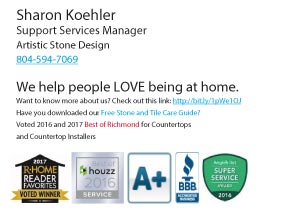Guidelines for Business E-Mail
Sharon Koehler
Artistic Stone Design
Back in the day before e-mail (yes, there was a time before e-mail), people used to write business letters. There are six parts of a business letter: the heading, inside address, greeting, the body, the close and the signature line. The business letter had guidelines to follow that every reasonably-educated person knew. For instance: the inside address was always typed on the left margin to show through the window of an envelope, the greeting always ended with a colon, there were no postscripts (P.S.) in a business letter, and the signature always needed to be in blue or black ink. Back in the day, a business letter was a very serious, proper thing.
Fast forward to today: the business letter has long since been replaced by the almost-instant e-mail. There is absolutely nothing wrong with e-mail. It speeds up the business process and provides documentation about what was discussed. No matter how you look at it, that’s a win-win all the way around. (Unless of course your e- mail ends up in a spam filter and no one sees it.)
While it is a win-win all the way around, believe it or not there are guidelines to follow for a proper business e-mail, as well.
#1 – Make sure you have a proper business e-mail address. Most businesses these days do have proper business e–mail addresses, but if you are applying for a job, it’s best to create a more business sounding address.
Partygirl92@ or Hotbody
babe85@ might be great for your personal life but that’s probably not the first impression you want to make on a possible new employer. A good e-mail address will have your name in it so people know who sent it.
#2 – The subject line needs to be clear and to the point. Studies show that most people decide whether to open an e-mail or not based on the subject line. So, instead of a subject line that is vague and unclear such as “Question” try “Question for you about the Smith job.”
 #3 – A business e-mail should have a signature block. This usually includes your name, title, company name and contact information. You can also add some publicity about yourself or your company but keep it sensible. This is my signature block:
#3 – A business e-mail should have a signature block. This usually includes your name, title, company name and contact information. You can also add some publicity about yourself or your company but keep it sensible. This is my signature block:
Impressive and eye-catching? Yes.
Informative? Yes.
A little over the top? Probably, but I am proud of my company’s accomplishments and awards.
#4 – Don’t get too personal or easy going. Greetings like “Hey,” “Yo” or “What Up” are fine for friendly e–mails, but in business these greetings are not acceptable. “Hello” is best with “Hi” a close second. Also, always be aware of who you are writing to. Does Michael go by Mike, or William by Will, or Bill? Don’t run the risk of offending anyone because they go by their given name and not a nickname.
#5 – Reply to all e–mails. A simple “Thanks” or “I got it” is all it takes to let the sender know you got it and it’s not hung up somewhere. If the e-mail is not meant for you and you got it by mistake, let the sender know that, as well.
#6 – Know your recipient. Since e-mail can be sent worldwide, be mindful of the person on the other end. There are cultural differences to take into account. Americans and Germans tend to be straighter to the point, while people from Japan and China tend to be more personal.
#7 – Humor is Not Your Friend. Many times, humor is in the visual and verbal presentation. It can lose a lot in the written word, so unless you know the person you’re writing to very well, don’t risk offending them.
#8 – Back off on the punctuation. Multiple exclamation points and question marks are a no-no. One exclamation point and one question mark are enough to get the point across!
Multiple question marks make you seem confused, and multiple exclamation points can make you appear childish.
#9 – Proofread, proofread and proofread! Absolutely proofread your e-mails, read them out loud if possible, and don’t just rely on spell-check. Too many words in our language are similar. Kite and kit, her and here, the and there, bear and bare, and don’t forget to, too and two. These words will pass a spell-check, as will hundreds of others, but those little errors can make you seem either uneducated or unprofessional, or both. And of course, please let your proof reading begin and end with the recipient. As I’m sure we all know, it is super embarrassing to send an e-mail to someone by mistake.
#10 – Stick to the Classics. For business e-mail, keep everything simple and easy to read. Font size should be no smaller than 10-12 point in black, in an easy-to-read style like Arial, Calibri, Times or Bookman Old Style. (Personally, I think this rule should be expanded to include blue color font as well, but that’s just me. Note that blue underlined web links in your e-mail are usually reserved to indicate an active link.)
Remember that these are guidelines for business e-mails. In business it’s all about looking professional. Some of these guidelines should carry over to our personal e-mails, but in your personal e-mails, feel free to express yourself less rigidly. In personal e-mails – to each his own.
Please send your thoughts on this article to Sharon at Sharon@asdrva.rocks.